![]()
![]()
![]()
Use LEFT and RIGHT arrow keys to navigate between flashcards;
Use UP and DOWN arrow keys to flip the card;
H to show hint;
A reads text to speech;
50 Cards in this Set
- Front
- Back
|
generating membrane potential |
- all cells exhibit a resting membrane potential between -5mv to -100mv - cell is polarized or in its polarized state when it is resting- or exhibiting resting potential - for muscle cells: polarized/resting means cell is not contracting - for a nerve cell: polarized/resting means call is not conducting electrical impulses |
|
|
polarized |
resting |
|
|
depolarized |
taking cell out of polarized state -membrane potential changes |
|
|
repolarized |
cell goes back into polarized state -membrane potential changes |
|
|
membrane potential changes |
- when ions move across the plasma membrane (in/out of the cell) this changes the cell membrane potential from polarized --> depolarized --> re-polarized |
|
|
substances in our cells |
- nutrients - respiratory gases (O2) -foreign substances that need to be destroyed |
|
|
substances out of our cells |
-wastes - respiratory gases (CO2) -proteins cells have made |
|
|
2 basic transport systems |
- active transport -passive transport |
|
|
active transport |
- requires ATP - 2 types: endocytosis, exocytosis, bulk transport, sodium/potassium pumps - low concentration --> high concentration |
|
|
passive transport |
- does not require energy - 3 types: simple diffusion, facilitated diffusion, osmosis -high concentration --> low concentration |
|
|
simple diffusion |
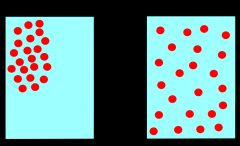
- substances want to move from an area of high concentration to an area of low concentration or "down the concentration gradient" - happens until concentrations are equal |
|
|
facilitated diffusion |
- when the substance is larger or polar and needs assistance to get across the membrane. a protein carrier/channel can assist the larger, more polar substance -but still require no energy - still from high --> low concentration |
|
|
osmosis |
- passive movement of water across a membrane - water always wants to dilute so it always moves to where solute concentration is higher |
|
|
bulk transport |
- the transport of bulk items (like proteins) in and out of the cell |
|
|
exocytosis |
-active --> requires transport - transport of substances from inside the cell to outside the cell ( like proteins) |
|
|
endocytosis |
- transport substances from outside the cell to inside (like nutrients) |
|
|
sodium/potassium pumps |
- ions are often actively transported across the plasma membrane from an area of low ion concentration to high ion concentration - will pump Na+ out of the cell and K+ into the cell to repolarize it |
|
|
things that affect the rate of simple diffusion (passive) |
1. temperature ( increase temp = increase rate) 2. concentration ( increase concentration = increase rate) 3. particle size (decrease size = increase rate) |
|
|
tonicity |
the ability of a solution* to change the shape (or tone) of a cell by altering water volume of cell *solutions: hypotonic, hypertonic, isotonic |
|
|
isotonic |
this type of water solution has the same solute concentration as the inside of the cell - when we put a cell in this solution, nothing happens --> there will be no water movement |
|
|
hypertonic solution |
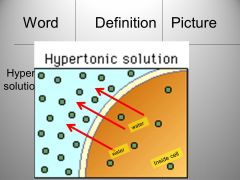
- this type of solution has a higher solute concentration than inside the cell - if we put a cell in this solution, water will move out of the cell and into the solution where the solute concentration is higher - if too much water moves out --> crenation |
|
|
hypotonic solution |
- this solution has a solute concentration that is lower than solute concentration in the cell - if we put cell in this solution, water will move into the cell from the solution. - cell will swell up and burst & die |
|
|
crenation |
when too much water moves out of cell, it shrivels up and dies |
|
|
protein synthesis |
- involves 2 basic steps: transcription & translation |
|
|
nucleic acids |
- deoxyribonucleic acid (DNA) - ribonucleic acid (RNA) |
|
|
DNA |
- deoxyribonucleic acid - "genes, genetic material, chromosomes" - found in nucleus -double stranded molecule twisted into double helix - DNA holds instructions for making all body's proteins, "blueprint of our body" |
|
|
RNA |
- ribonucleic acid - single stranded molecule - RNA moves from nucleus --> cytoplasm --> nucleus - RNA = "molecular slave" - fxn: take copy of DNA's instructions and actually build the proteins |
|
|
3 types of RNA |
- messenger RNA (mRNA) - transfer RNA (tRNA) - ribosomal RNA (rRNA) |
|
|
messenger RNA |
- mRNA - the "messenger", it takes the copy of DNA's instructions out of the nucleus and into the cytoplasm where the ribosomes are |
|
|
transfer RNA |
-tRNA -transfers individual amino acids to the ribosome so we can make the polypeptide chain (amino acids --> polypeptide chain - protein) |
|
|
ribosomal RNA |
- rRNA - actually part of the ribosome structure, functions in making the protein |
|
|
Transcription |
- where information is converted from one format to a different format -information does not change during conversion |
|
|
transcription protein synthesis |
-occurs in the nucleus & involves only DNA and mRNA - DNA helix unwinds itself and the strands separate --> mRNA makes a copy of DNA's instructions --> mRNA will deliver that info to the ribosomes in the cytoplasm |
|
|
Translation |
- where the protein is actually being made /synthesized -the info is changed/converted from one language to another language |
|
|
translation protein synthesis |
-mRNA brings DNA's instructions to the ribosome --> tRNA transfers the individual amino acids to the ribosome --> rRNA assembles the amino acids to make protein |
|
|
mitosis |
the process of cell division used by all the body cells (except egg & sperm cells) |
|
|
meiosis |
the process of cell division only used by egg and sperm cells |
|
|
why do cells divide? (mitosis) |
1. growth 2. replacement of cells |
|
|
4 phases of mitosis |
1. prophase 2. metaphase 3. anaphase 4. telophase |
|
|
interphase |
- is NOT a phase of mitosis - cell spends most of its life cycle in this phase - there are 3 sub-phases: gap (G1), S, Gap 2 (G2) - cell carries out normal activities & prepares for mitosis |
|
|
prophase |
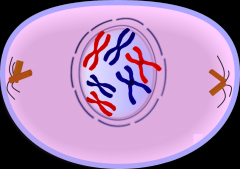
- cell breaks down nuclear envelope - centrioles form mitotic spindles - DNA changes chromatin to chromosomes |
|
|
metaphase |

- shortest phase - nuclear envelope is gone & centrioles have formed mitotic spindles -chromosomes line up at the middle of the mitotic spindle - meta = middle |
|
|
anaphase |
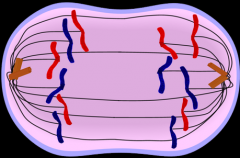
- spindle fibers pull chromosome pairs apart & to opposite ends of the cell |
|
|
telophase |
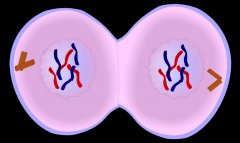
- cell is starting to pinch off - cell begins to make 2 nuclear envelopes - cell breaks down mitotic spindle - DNA changes back to chromatin form -cytokinesis ends & division is complete |
|
|
cytokinesis |
the division of the cytoplasm during mitosis, starts at the end of anaphase |
|
|
regeneration capacity of cells |
* excellent regeneration capacity * moderate regeneration capacity * no regeneration capacity |
|
|
excellent regeneration capacity |
- epithelial cells (skin) - bone cells |
|
|
moderate regeneration capacity |
- dense connective tissue (ligaments & tendons) |
|
|
no regeneration capacity |
- cardiac muscle cells - neurons on central nervous system (brain and spinal cord) |
|
|
after mitosis |
- two daughter cells are identical to mother cell but will be smaller --> interphase to grow and make proteins --> eventually they will also go through mitosis |

